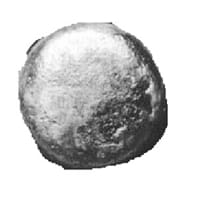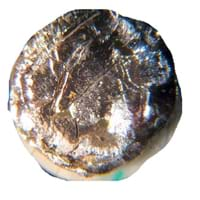Plutonium Americium Comparison
Periodic Table
Symbol
Pu
Am
Group Number
0
18
Not Available
Period Number
7
7
Block
f block
f block
Element Family
Actinide
Actinide
CAS Number
7440075
99+
7440359
99+
Space Group Name
P121/m1
P63/mmc
Space Group Number
11.00
13
194.00
5
Facts
Interesting Facts
- Plutonium metal if obtain from ores of uranium metal.
- Plutonium metal is very sensitive to the change in atmospheric conditions like temperature and pressure.
- Americium metal is produced by bombarding Plutonium with Neutrons.
- Americium metal was discovered as a by-product while testing an atomic bomb (Manhattan Project).
Sources
Mining, Ores of metals
Obtained By Bombarding Plutonium with Neutrons
History
Who Discovered
Glenn T. Seaborg, Arthur Wahl, Joseph W. Kennedy, Edwin McMillan
Glenn T. Seaborg, Ralph A. James, Leon O. Morgan, Albert Ghiorso
Discovery
In Between 1940 1941
In 1944
Abundance
Uses
Uses & Benefits
- Plutonium was used in atomic bombs and still it is being used in various weapons and Ammunition industry.
- It is also used in nuclear power plant as source of energy for space missions.
- Americium metal is used in smoke detection alarms.
- In the future, this metal has a potential to be used in batteries of spacecrafts.
Industrial Uses
Aerospace Industry, Ammunition Industry
NA
Medical Uses
NA
NA
Other Uses
Alloys
Alloys, Nuclear Research, Research Purposes
Biological Properties
Toxicity
Toxic
Toxic
Present in Human Body
No
No
In Blood
0.00 Blood/mg dm-3
37
0.00 Blood/mg dm-3
37
In Bone
0.00 p.p.m.
36
0.00 p.p.m.
36
Physical Properties
Melting Point
639.50 °C
99+
994.00 °C
99+
Boiling Point
3,235.00 °C
24
2,607.00 °C
99+
Appearance
Physical State
Solid
Solid
Color
Silvery White
Silvery White
Luster
NA
NA
Hardness
Speed of Sound
2,260.00 m/s
99+
Not Available
Optical Properties
Allotropes
No
No
α Allotropes
Not Available
Not Available
β Allotropes
Not Available
Not Available
γ Allotropes
Not Available
Not Available
Chemical Properties
Chemical Formula
Pu
Am
Isotopes
Known Isotopes
20
19
16
23
Electronegativity
Pauling Electronegativity
1.28
33
1.30
32
Allred Rochow Electronegativity
1.22
26
1.20
27
Electropositivity
Pauling Electropositivity
2.72
21
2.70
22
Ionization Energies
1st Energy Level
584.70 kJ/mol
99+
578.00 kJ/mol
99+
2nd Energy Level
1,128.00 kJ/mol
99+
1,158.00 kJ/mol
99+
3rd Energy Level
2,084.00 kJ/mol
99+
2,132.00 kJ/mol
99+
4th Energy Level
3,338.00 kJ/mol
99+
3,493.00 kJ/mol
99+
Electrochemical Equivalent
2.28 g/amp-hr
22
3.02 g/amp-hr
17
Electron Work Function
Not Available
Not Available
Other Chemical Properties
Corrosion, Ionization, Radioactive Isotopes, Radioactivity
Ionization, Radioactive Isotopes, Radioactivity, Solubility
Atomic Properties
Atomic Number
94
24
95
23
Electron Configuration
[Rn] 5f6 7s2
[Rn] 5f7 7s2
Crystal Structure
Monoclinic (MON)
Double Hexagonal Close Packed (DHCP)
Crystal Lattice
MON-Crystal-Structure-of-Plutonium.jpg#100
DHCP-Crystal-Structure-of-Americium.jpg#100
Atom
Number of Protons
94
24
95
23
Number of Neutrons
150
11
148
12
Number of Electrons
94
24
95
23
Radius of an Atom
Atomic Radius
159.00 pm
28
173.00 pm
21
Covalent Radius
187.00 pm
20
180.00 pm
21
Van der Waals Radius
200.00 pm
28
244.00 pm
10
Atomic Weight
244.00 amu
19
243.00 amu
20
Atomic Volume
12.32 cm3/mol
99+
17.86 cm3/mol
29
Adjacent Atomic Numbers
Valence Electron Potential
64.90 (-eV)
21
44.00 (-eV)
40
Lattice Constant
618.30 pm
4
346.81 pm
99+
Lattice Angles
NA
π/2, π/2, 2 π/3
Lattice C/A Ratio
Not Available
Not Available
Mechanical Properties
Density
Density At Room Temperature
19.82 g/cm3
13
12.00 g/cm3
30
Density When Liquid (at m.p.)
16.63 g/cm3
8
Not Available
Tensile Strength
Not Available
Not Available
Viscosity
Not Available
Not Available
Vapor Pressure
Vapor Pressure at 1000 K
0.00 (Pa)
26
0.00 (Pa)
13
Vapor Pressure at 2000 K
2.20 (Pa)
12
Not Available
Elasticity properties
Shear Modulus
43.00 GPa
18
Not Available
Young's Modulus
96.00 GPa
21
Not Available
Poisson Ratio
0.21
32
Not Available
Other Mechanical Properties
Ductile, Malleable
NA
Magnetic Properties
Magnetic Characteristics
Specific Gravity
19.84
7
13.67
15
Magnetic Ordering
Paramagnetic
Paramagnetic
Electrical Properties
Electrical Property
Poor Conductor
Unknown
Resistivity
1.46 nΩ·m
99+
0.69 nΩ·m
99+
Electrical Conductivity
0.01 106/cm Ω
99+
0.02 106/cm Ω
99+
Thermal Properties
Specific Heat
0.13 J/(kg K)
39
0.11 J/(kg K)
99+
Molar Heat Capacity
35.50 J/mol·K
3
62.70 J/mol·K
1
Thermal Conductivity
6.74 W/m·K
99+
10.00 W/m·K
99+
Critical Temperature
Not Available
Not Available
Thermal Expansion
46.70 µm/(m·K)
6
Not Available
Enthalpy
Enthalpy of Vaporization
344.00 kJ/mol
25
Not Available
Enthalpy of Fusion
2.82 kJ/mol
99+
14.39 kJ/mol
24
Enthalpy of Atomization
360.00 kJ/mol
26
268.00 kJ/mol
40
Standard Molar Entropy
Not Available
Not Available
|
||
|
||
|












